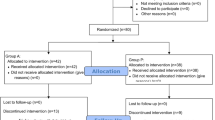Abstract
Background
Sciatic nerve block is a commonly used technique for providing anesthesia and analgesia to the lower extremity. At the parasacral level, the nerve block is classically performed via a posterior approach in lateral decubitus position causing patient’s discomfort. Therefore, we aimed to conduct an anatomical study describing a new lateral approach to the parasacral sciatic nerve in supine position.
Methods
The skin entry point was located on the vertical line through the greater trochanter (GT) at the midpoint between the anterior superior iliac spine (ASIS) level and the GT. The angle to the skin was 10° dorsally oriented. According to these palpable anatomical landmarks, the parasacral lateral approach was simulated bilaterally in four cadavers in supine position. Anatomical dissection allowed assessment of the needle tip position with regard to the sciatic nerve. Then, to refine the anatomical description of this new lateral approach, 40 pelvic computer tomography (CT) examinations were retrospectively selected and post-processed to bilaterally simulate the needle route to the sciatic nerve. The skin–nerve distance, the optimal angle to the skin, and the sciatic nerve anteroposterior diameter at parasacral and ischial tuberosity levels, respectively were recorded by two independent readers.
Results
Cadaver dissection showed that the needle tip was placed in the vicinity of the sciatic nerve in 8/8 cases. Then, CT-simulated lateral approach demonstrated a mean skin–nerve distance of 128 mm (81–173), and a 12° dorsally oriented (5–22) optimal angle to the skin. The sciatic nerve anteroposterior diameter was 10 mm (7–15) at the parasacral level, and 7 mm (5–10) more caudally at the ischial tuberosity level. No significant intra- or inter-observer variability was observed.
Conclusion
This study describes a new lateral approach to the parasacral sciatic nerve block in supine position. These anatomical results should be confirmed by further clinical studies.



Similar content being viewed by others
References
Ben-Ari AY, Joshi R, Uskova A, Chelly JE (2009) Ultrasound localization of the sacral plexus using a parasacral approach. Anesth Analg 108:1977–1980
Chelly JE, Delaunay L (1999) A new anterior approach to the sciatic nerve block. Anesthesiology 91:1655–1660
Cuvillon P, Ripart J, Jeannes P, Mahamat A, Boisson C, L’Hermite J et al (2003) Comparison of the parasacral approach and the posterior approach with single- and double-injection technique to block the sciatic nerve. Anesthesiology 98:1436–1441
di Benedetto P, Bertini L, Casati A, Borghi B, Albertin A, Fanelli G (2001) A new posterior approach to the sciatic nerve block: a prospective, randomized comparison with the classic posterior approach. Anesth Analg 93:1040–1044
Hadzic A, Vloka JD (2003) Peripheral nerve blocks: principles and practice. In: Hadzic A, Vloka JD (eds) Anesthesia and analgesia. McGraw Hill, New York, pp 219–224
Hagon BS, Itani O, Bidgoli JH, Van der Linden PJ (2007) Parasacral sciatic nerve block: does the elicited motor response predict the success rate? Anesth Analg 105:263–266
Liu SS, Salinas FV (2003) Continuous plexus and peripheral nerve blocks for postoperative analgesia. Anesth Analg 96:263–272
Mansour NY (1993) Reevaluating the sciatic nerve block: another landmark for consideration. Reg Anesth 18:322–323
Morris GF, Lang SA, Dust WN, Van der Wal M (1997) The parasacral sciatic nerve block. Reg Anesth 22:223–228
O’Connor M, Coleman M, Wallis F, Harmon D (2009) An anatomical study of the parasacral block using magnetic resonance imaging of healthy volunteers. Anesth Analg 108:1708–1712
Ripart J, Cuvillon P, Nouvellon E, Gaertner E, Eledjam JJ (2005) Parasacral approach to block the sciatic nerve: a 400 case survey. Reg Anesth Pain Med 30:193–197
Tran D, Clemente A, Finlayson RJ (2007) A review of approaches and techniques for lower extremity nerve blocks. Can J Anaesth 54:922–934
Uz A, Apaydin N, Cinar SO, Apan A, Comert B, Tubbs RS, Loukas M (2010) A novel approach for anterior sciatic nerve block: cadaveric feasibility study. Surg Radiol Anat [Epub ahead of print]
Valade N, Ripart J, Nouvellon E, Cuvillon P, Prat-Pradal D, Lefrant JY et al (2008) Does sciatic parasacral injection spread to the obturator nerve? An anatomic study. Anesth Analg 106:664–667
Winnie AP, Ramamurthy S, Durrani Z, Radonjic R (1974) Plexus blocks for lower extremity surgery. Anesthesiol Rev 1:11–16
Conflict of interest
The authors declare no conflict of interest.
Author information
Authors and Affiliations
Corresponding author
Rights and permissions
About this article
Cite this article
Le Corroller, T., Wittenberg, R., Pauly, V. et al. A new lateral approach to the parasacral sciatic nerve block: an anatomical study. Surg Radiol Anat 33, 91–95 (2011). https://doi.org/10.1007/s00276-010-0709-2
Received:
Accepted:
Published:
Issue Date:
DOI: https://doi.org/10.1007/s00276-010-0709-2




